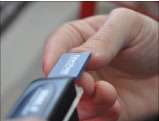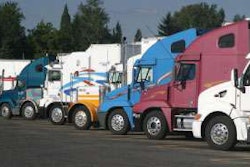The sandman cometh
Treating drivers with sleep disorders can cut medical costs, improve safety
In November 2010, the Federal Motor Carrier Safety Administration announced plans to revise the physical qualification regulations for commercial motor vehicle drivers. These changes – which almost surely will include new screening standards for sleep disorders – will be based on new guidance from FMCSA’s Medical Review Board and will impact the standards for the U.S. Department of Transportation physical exam that is required every two years.
 Drivers using Sleep Pointe’s APAP machines use a “SmartSticks” USB drive to upload sleep data through the ACS sleep apnea reporting service.
Drivers using Sleep Pointe’s APAP machines use a “SmartSticks” USB drive to upload sleep data through the ACS sleep apnea reporting service.Obstructive sleep apnea, the most common sleep disorder among drivers, is caused by the airway being blocked during sleep. The body wakes up a minimum of 15 to 20 times an hour to restore breathing. Besides causing daytime drowsiness, OSA can lead to serious health issues such as hypertension, diabetes and cardiovascular disease.
According to an oft-cited research project by Dr. Allan Pack of the University of Pennsylvania, up to 28 percent of commercial drivers have a severe form of OSA. Other studies found that drivers with untreated sleep disorders are up to seven times more likely to be involved in a crash, a risk equal to that of drunk driving with a Blood Alcohol Content of 0.08.
With a highly mobile and decentralized work force, most commercial and private fleets traditionally have not been able to easily address the problem of sleep apnea within their driver ranks. But during the past few years, many companies have started using new services and technology to solve this challenge.
Outsourcing treatment
Scheduling drivers for sleep tests is the first challenge. In 2000, Prime Inc. contracted with a medical provider to open an onsite family practice. The Springfield, Mo.-based company’s 5,700 driver associates, both employees and independent contractors, also use its medical facility for DOT physical exams.
Prime also contracted with Sleep Pointe, an OSA diagnosis and treatment provider. Sleep Pointe, which operates a sleep lab on the fleet’s property, conducts full polysonogram testing if Prime’s doctor believes the associate may have a sleep disorder.
Associates pay for the doctor’s visits and sleep testing themselves. Through Sleep Pointe, Prime is able to offer full diagnostics, treatment and compliance services to drivers for at least 50 percent less than what it would cost elsewhere, says John Hancock, director of recruiting.
Since most fleets lack the volume to contract with an onsite vendor, companies that specialize in treating sleep disorders for the transportation industry have created national networks to make it convenient for drivers to be diagnosed and treated.
SleepSafe Drivers now has a national network of more than 55 locations, and the company plans to expand to more than 200 sites by yearend. SleepSafe uses an ambulatory testing program where drivers are given a small device to monitor their sleep in a natural location, such as in their cab, hotel or home.
Testing and diagnosing drivers may be easy compared to getting them to comply with their treatment plans. Generally, the treatment involves using a continuous or automatic positive airway pressure (CPAP or APAP) device when sleeping.
As part of the overall service, vendors provide the systems and staff to monitor drivers’ compliance with the treatment plan. They will follow up with drivers personally if needed.
Many fleets are using new services and technology to address sleep apnea among drivers.
ACS Expedited Solutions and Sleep Pointe have created a sleep apnea safety compliance system using the ACS TripPak Truck Stop Scanning network. Drivers using Sleep Pointe’s APAP machines use a “SmartSticks” USB drive to upload sleep data through the ACS sleep apnea reporting service. The system has been in place for a year and has had more than 20,000 data uploads from drivers.
SleepSafe Drivers uses a wireless device on its APAP machines to transmit daily information about usage. The company has sleep coaches who follow up with drivers who did not use the device for the minimum amount of time each day, says Dana Voien, president.
Comdata now offers a service that includes companywide screenings, nationwide scheduling, single-night testing, immediate diagnosis and treatment of sleep disorders, as well as driver compliance reporting. The program is administered by Sleep Access, a provider of health and wellness platforms for the transportation industry.
Comdata customers that use Sleep Access have flexible billing and payment programs that tie into their existing fuel and Mastercard purchase programs, says Cory Sickles, Comdata’s vice president and product executive.
Sleep Access works with a carrier’s DOT physician to follow up with drivers who have been identified as needing testing and treatment for sleep disorders. Sleep Access also monitors driver compliance.
Drivers with untreated sleep disorders can have a significant impact on health care costs and safety performance. Fleets that do not have programs in place to address the problem also may see it impact driver retention, especially as FMCSA adds more stringent requirements to the DOT physical exam.
IN BRIEF
* Pegasus TransTech (www.transflo.com) announced that 12 new locations for Transflo Express truckstop scanning have been added in Canada, tripling the number of Pilot Flying Js in the Transflo Express Canadian network. The truckstops range from the Ontario province in the east to British Columbia on the Pacific.
* Getloaded (www.getloaded.com), a Web-based logistics service to match freight to trucks, launched a service in Spanish at Getloaded.com/espanol. Members who use the Spanish language feature will have access to Getloaded.com’s full functionality.
* Teletrac (www.teletrac.net) released Fleet Director 8.5, the latest version of its fleet management telematics system. A new trending analytics feature elps fleet managers improve profit-and-loss factors such as fuel consumption and safety performance, allowing users to spot performance peaks and valleys over a three-month period.
* Transportation Costing Group (www.tcgis.com) launched its next-generation Cost Information System, CIS/NG, an activity-based costing and profitability management system for less-than-truckload carriers.
Rand McNally launches EOBR device
Rand McNally has developed a next-generation in-cab electronic onboard recorder that combines navigation with a robust mobile communication system. The Rand McNally TND 760 Fleet Edition integrates into a truck’s onboard computer and sends and receives information via both Wi-Fi and cellular.
The TND 760 can be set up in less than 30 minutes and does not require the installation of a separate “black box” monitoring unit. The device features a broad array of capabilities, including fleet communications via e-mail, driver and vehicle performance monitoring, electronic hours-of-service compliance and truck-specific navigation. Fleet activity information is managed via Rand McNally’s enhanced FleetWatcher Web-based portal.
The TND 760 is a result of the business partnership recently formed between Rand McNally and DriverTech. In September 2010, Rand McNally took an investment stake in DriverTech and acquired an exclusive license to DriverTech’s technology in the trucking space. Since then, the development teams at both companies have worked to port DriverTech’s software over to Rand McNally’s hardware platform.
PeopleNet announces new features, partnerships
At the ninth annual PeopleNet Users Conference last month in Boca Raton, Fla., executives announced new features, enhancements and partnerships for the company’s in-cab computing and mobile communications platforms.
PeopleNet announced a discount opportunity through Brazos Risk Insurance, which is offering a 5 to 10 percent reduction in premiums to qualified fleets that use the PeopleNet onboard computing system with SpeedGauge service to monitor drivers’ actual speeds to posted speed limits, by road segment. Through its partnership with SpeedGauge, PeopleNet plans to add real-time excessive speed alerts and new metrics to an in-cab driver scorecard.
PeopleNet also has enhanced its driver vehicle inspection report (DVIR) form and created a streamlined login process for drivers. The company will be working with a design firm to redesign the driver interface for its Windows-based BLU and Tablet platforms to simplify and improve usability of the in-cab computer. Future possibilities for the platforms include driver entertainment options.
PeopleNet and in-cab navigation partner Maptuit announced a new feature that will send an e-mail alert to fleet managers when drivers go out of route.
In 2012, Vusion – a PeopleNet division that provides a platform to integrate data from equipment manufacturers with fleet performance data – plans to offer new industry benchmarking tools for fuel economy and other metrics, allowing fleet customers to compare their performance to peers of their same size and type of operations.
PeopleNet’s newest platform, BLU.2, soon will have in-cab scanning through ACS and in-cab training through ITI. The company also announced the addition of two companies – Doran and BatRF by Stemco – that integrate with its Tire Pressure Monitoring Service; PeopleNet initially began offering the service in 2010 with Advantage PressurePro.
PeopleNet also announced the expansion of its Lane Departure Warning integration network with the addition of new partners Takata SafeTrak and Mobileye. The small integrated unit consists of a camera, onboard computer and software.












